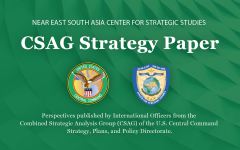Sudan Low-Intensity Conflict and Its Impact on North Africa and Sahel Region
May 30, 2023 2023-05-30 18:24Sudan Low-Intensity Conflict and Its Impact on North Africa and Sahel Region
Sudan Low-Intensity Conflict and Its Impact on North Africa and Sahel Region
NESA Center Alumni Publication
Dr. Arslan Chikhaoui (Chairman of NSV Consultancy & Studies Center and Advisory Board Member of the Defense and Security Forum)
24 May 2023
The 32nd Arab Summit in Jeddah addressed the issue of low-intensity conflict in Sudan. Indeed, given the position of Sudan, the crisis in this country has undoubtedly had an impact in the sub-Saharan region, including in the Sahel and in the countries of North Africa. These countries are not immune to the ongoing low-intensity conflict, largely because of the common Arab cultural and political ties that unite them. The danger now posed by the potential repercussions of the Sudanese crisis on North African countries is a source of major concern for other Arab countries.
The first concern is that the situation in Libya is one of the most worrying, given that the country is mired in a power struggle between East and West and that the warring factions have complex links with the parties involved in the Sudanese crisis. This could undermine any future inclusive reconciliation in Libya.
The second concern is the potential impact on the political situation in Chad and the security and humanitarian problems that could arise for other countries in the Sahel, including Mali and Niger. The Chadian government is perhaps rightly concerned that opposition armed forces in the country may seek some form of alliance with Sudan’s rapid support forces. The growing political vulnerability of Chad and Libya could lead to foreign military intervention, which would create other problems. Such unrest is fertile ground for Violent Extremist Organizations (VEOs), allowing them to move freely throughout the ungoverned Sahel region. These groups still feel empowered by the 2011 protests and the resulting lack of security across the region. It is perhaps obvious to point out that the relatively improved security in the region following the so-called “Arab Spring” protests has led to a consequent decline in the activities of various terrorist groups.
The Sudanese crisis could also prompt terrorist groups to intensify their activities in the border regions between Tunisia and Algeria. These groups are entrenched in the Chaambi Mountains in Tunisia and all along the Algerian-Libyan border areas to northern Mali. In such circumstances, the likelihood of an attack similar to the one in 2013, which targeted a gas facility in the Algerian region of Tiguentourine, increases. For the record, the attackers’ starting point for this operation was the border area between Niger and Libya. The terrorist group cites France’s “Serval” military intervention in Mali as justification for that malicious action. Algeria rightly recalls that a solution to the Sudanese crisis had to be found by avoiding any foreign military intervention, which it considers to be one of the main reasons for the intensification of the various crises in the region.
In addition, North African countries fear the security threats posed by illegal immigration, asylum seekers, narcotic trafficking, and organized crime in all its forms since these countries are located on the southern shore of the Mediterranean, from which boats carry illegal migrants to Europe. In recent years, the number of asylum seekers and illegal immigrants heading to North African countries has increased due to deteriorating conditions in the Sahel countries. While the countries of North Africa were previously only transit points, they have now become a main hub for those seeking to immigrate illegally to Europe, seen as an “Eldorado.” This has caused several internal problems in these countries. The latest concerns accusations of racism leveled against Tunisia because of the way it treats African refugees and immigrants. This even prompted the Tunisian presidency to publish details to reject such accusations.
The third concern is that structural problems in the countries of the Sahel could hamper their ability to prevent the Sudanese crisis from spreading in their countries. If this conflict evolves, it could plunge the entire region into the conditions that prevailed before the first wave of what is being called the “Arab Spring.” It is undeniable that these countries are stepping up their efforts to maintain their security and stability, in addition to contributing to international efforts aimed at achieving a peaceful resolution to the low-intensity conflict in Sudan.
Last but not least, the fourth concern is that the low-intensity conflict in Sudan, which threatens to blow up the ungoverned Sahel zone, could be a justification for maintaining the Status Quo of the Western Sahara issue.
The views presented in this article are those of the speaker or author and do not necessarily represent the views of DoD or its components.






